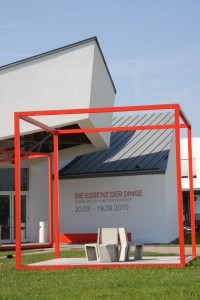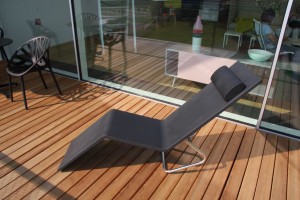Vitra Design Museum Workshop: Part 1 – The Idea
Parallel to its exhibitions the Vitra Design Museum organises workshops designed not only to accompany the exhibitions but much more to expand on them and so offer participants a new, active, insight into the theme. Or at least an aspect of the theme.
For the current exhibition “Essence of Things. Design and the Art of Reduction” this means, among others, workshops on cardboard furniture production.
Cardboard is without question one of the more challenging products that one can choose for furniture design.
As a cheap, plentiful and – generally- environmentally responsible product it appears to be perfect for use in modern furniture design.
Perfect that is were it not for its inherent instability and fragility problems.
Loving problems as we do we signed up for the workshop.
Having committed our first task was to decide on the product we wanted to develop.
Three sources of inspiration were to act as our guides.
Firstly the concept of the exhibition: Essence of Things. Design and the Art of Reduction. Reduction. Regardless what we decided upon it had to involve using the design process to help “reduce” the product.
Among the current products on the market that make use of reduction in design is Chairless by Alejandro Aravena for Vitra.
As a product Chairless claims to remove the chair from the chair. And as such was our second source of inspiration.
For although we like the Chairless concept, for us what is actually does is take the static equilibrium that exist in a chair and replaces that with the system of muscular forces within the human body.
As such the user of Chairless is restricted in his or her movement, as every movement upsets the distribution of forces within the system thus creating instability. If you want to read your friends magazine, but it’s lying to far away – you have to “break” the chair in order to reach the magazine.
And so we decided to take up the “Chairless” idea and develop it with the intention of creating a truly “chairless” chair system that still allows the user full mobility.
Fairly quickly we landed upon the idea of a foldable system and taking our guidance from Maarten van Severn, an expert in reduced design, we based our concept on the geometry of his MVS Chaise.
The principle problem was – as always with cardboard – how do we guarantee the stability of the product?
With other materials such as plastic, wood or concrete one has a certain degree of inherent stability.
With cardboard one has to introduce the stability as a component of the design.
Frank Gehry, for example achieved the stability in his “Easy Edges” series through the layering of cardboard: chairs such as the Wiggle Side Chair being created by gluing numerous layers of cardboard together under extreme pressure.
The other “classic” solutions when working with cardboard are folding and insertion.
The question facing us was how could we best design our product, without losing sight of the desire to have it as “reduced” as possible.
And it was this question that was to dominate the development phase.
Tagged with: Chairless, Frank Gehry, Maarten Van Severen, MVS chaise, Vitra, Vitra D, Wiggle chair


